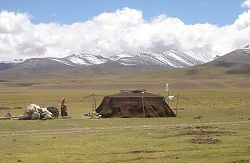Nomad

Communities of nomadic people move from place to place, rather than settling down in one location. Many cultures have been traditionally nomadic, but nomadic behaviour is increasingly rare in industrialised countries. Typically there are two kinds of nomads, pastoral nomads and peripatetic nomads. Pastoralists raise herds and move with them so as not to deplete pasture beyond recovery in any one area. Peripatetic nomads are more common in industrialised nations travelling from place to place offering a trade wherever they go. Nomadism is suggested to have originated throughout three stages that accompany population growth and an increase in the density of social organization. Sadr has suggested the following stages:
- Pastoralism This is a mixed economy with a symbiosis within the family.
- Agropastoralism This is when symbiosis is between segments or clans within an ethnic group.
- True Nomadism This is when symbiosis is at the regional level, mostly it starts between specialized nomadic and agricultural populations.
Nomadic lifestyle
(Nomads) were bands of travelers who moved from campsite to campsite, while following game and types of grain or fruits. It (a nomadic lifestyle) consisted of staying short periods at a campsite, and then picking up and leaving when the food moved. They (nomads) had a basically easy life with enough to eat and few possessions.
Attributes of nomads
Due to the nomads fateful decision, much lay in store for humankind. They left behind their easy life (see Nomadic Lifestyle above) for a life of hard work, enough to eat (as before) and economic surplus. As archeologist V. Gordon Childe said; "...a mild acquistiveness could now take its place among human desires." The decision made seperately by thousands of little bands (of nomads)over tens of thousands of eyars to join in the civilization of society led to men and women setteling down and a prosperous life of farming and herding.
History of nomadic peoples
Nomadic pastoralism seems to have developed as a part of the secondary products revolution proposed by Kurt Flannery, in which early pre-pottery neolithic cultures, that had used animals in order to store live meat (on the hoof) began also using animals for their secondary products, for example, milk, wool, hides, manure and traction.
The first nomadic pastoral society developed in the period from 6200 - 6000 B.C.E. in the area of the southern Levant. There during a period of increasing aridity, PPNB cultures in the Sinai were replaced by a nomadic pastoral pottery using culture, which seems to have been a cultural fusion between a newly arrived mesolithic people from Egypt (the Harifian culture), adopting their nomadic hunting lifestyle to the raising of stock. This quickly developed into what Jaris Yurins has called the circum-Arabian nomadic pastoral techno-complex and is possibly assocoated with the appearance of Semitic languages in the region of the Ancient Near East. The rapid spread of such nomadic pastoralism was typical of such later developments as of the Yamnaya culture of the horse and cattle nomads of the Eurasian steppe, or of the Turko-Mongol spread of the later Middle Ages.
- Eurasian Avars
- Hephthalites
- Khazars
- Wu Hu of China
- Most Sami communities
Nomadic people in industrialized nations
Indigenous nomadic peoples
- Pygmies
- Ababdeh of Egypt
- Bakhtiari of Iran
- The Bedouin
- Innu of Quebec
- Kuchis (Kochai) of Afghanistan
- Tuaregs
- Nenets
- Moken of Thailand and Myanmar
- Mrazig of Tunisia
- Bushmen of souther Africa
Many Native Americans and Indigenous Australians were nomadic prior to Western contact, although they were not a pastoral people in that they did not systematically raise animals on whose products they depended.
Further reading
- Sadr, Karim. The Development of Nomadism in Ancient Northeast Africa, University of Pennsylvania Press, 1991. ISBN 0812230663
- Cowan, Gregory. Nomadology in Architecture: Ephemerality, Movement and Collaboration University of Adelaide 2002 (available: [1])
- Grousset, René. L'Empire des Steppes (1939)
- Deleuze, Gilles and Guattari, Félix, A Thousand Plateaus (1980)
Credits
New World Encyclopedia writers and editors rewrote and completed the Wikipedia article in accordance with New World Encyclopedia standards. This article abides by terms of the Creative Commons CC-by-sa 3.0 License (CC-by-sa), which may be used and disseminated with proper attribution. Credit is due under the terms of this license that can reference both the New World Encyclopedia contributors and the selfless volunteer contributors of the Wikimedia Foundation. To cite this article click here for a list of acceptable citing formats.The history of earlier contributions by wikipedians is accessible to researchers here:
The history of this article since it was imported to New World Encyclopedia:
Note: Some restrictions may apply to use of individual images which are separately licensed.
